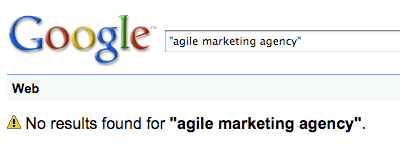· by James Archer · 4 min read
Can a Marketing Agency be Agile?
After years of soul searching, experimentation, and dipping our toes in the water, we here at Forty have finally committed to fully adopting the Agile methodology across the board. This is a pretty radical change for a marketing agency. The Agile methodology was developed in the software industry, a…

After years of soul searching, experimentation, and dipping our toes in the water, we here at Forty have finally committed to fully adopting the Agile methodology across the board.
This is a pretty radical change for a marketing agency. The Agile methodology was developed in the software industry, and for the most part has stayed there (albeit with great success). Most marketing professionals don’t even know the methodology exists, let alone have implemented it.

We’re probably not the first agency to adopt this methodology (there must be some out there), but it’s still uncharted territory, and while there’s much we can learn from others, we’re also going to have to figure out a lot on our own.
Err…What the Heck is “Agile”?
If you’re used to the word “methodology” meaning “tons of paperwork and annoying procedures,” Agile may come as a pleasant surprise.
According to the Agile Manifesto, this methodology values…
* Individuals and interactions over processes and tools
* Working software over comprehensive documentation
* Customer collaboration over contract negotiation
* Responding to change over following a plan
Over the years, a variety of elaborations and refinements of those basic principles have become prominent, but those are the key tenets of the Agile approach.
Agile is NOT What You’re Used To
Most people (especially those hiring a traditional design/marketing agency) are accustomed to a “waterfall” process, in which the whole project is planned out beforehand (with detailed scope and budget guidelines), and broken into discrete stages requiring deliverables, reviews, sign-offs, etc.
We’ve used that method for years, and it sucks. The only reason for all those scope documents are so the agency and client can argue with each other later about who did something wrong, when the problem could have been solved early on by simply talking instead of worrying about a comprehensive paper trail.
Why would we stick with a methodology based on the antiquated notion that we can accurately predict and plan for the future? That may have worked 20-30 years ago, but the industry simply moves far too fast for that to be effective now.
Design/marketing projects simply evolve too quickly (based on competition, new technologies, changing trends, etc.) to accurately plan it all out in the beginning. We need a methodology that is nimble, flexible, and able to respond quickly. In a word: Agile.
What the Agile Methodology Means to Forty
We’re still sorting out the specifics of our day-to-day routine, but these are the principles behind our own implementation of the Agile methodology:
- We believe in a single project team, comprising members of both our and our client’s organizations. (There is no “Us and Them,” just a single team working together.)
- We believe project team members should interact freely, without a project manager getting in the way.
- We believe the project team should have frequent (even daily) conversations.
- We believe real communication happens face to face or over the phone. (E-mail should be a last resort.)
- We believe in showing and discussing rough work (sketches, partial designs, etc.), instead of trying to perfect them before showing the client.
- We believe in delivering business value as early (and as frequently) as possible.
- We believe the project team should measure all work performed against identified business goals.
- We believe projects do (and should) evolve; we welcome course corrections.
- We believe in sustainable work habits. Weekends and evenings give everyone time to think, rest, and recharge.
- We believe project team members share accountability for results and performance. (Finger pointing is counterproductive.)
- We believe each project is unique, and requires flexibility regarding strategies, processes, and practices.
- We believe in learning, having fun, and doing great work.
We’ve been headed this direction anyway, but officially adopting Agile gives us a much-needed kick in the pants to formalizing our processes and workflow around these concepts.



